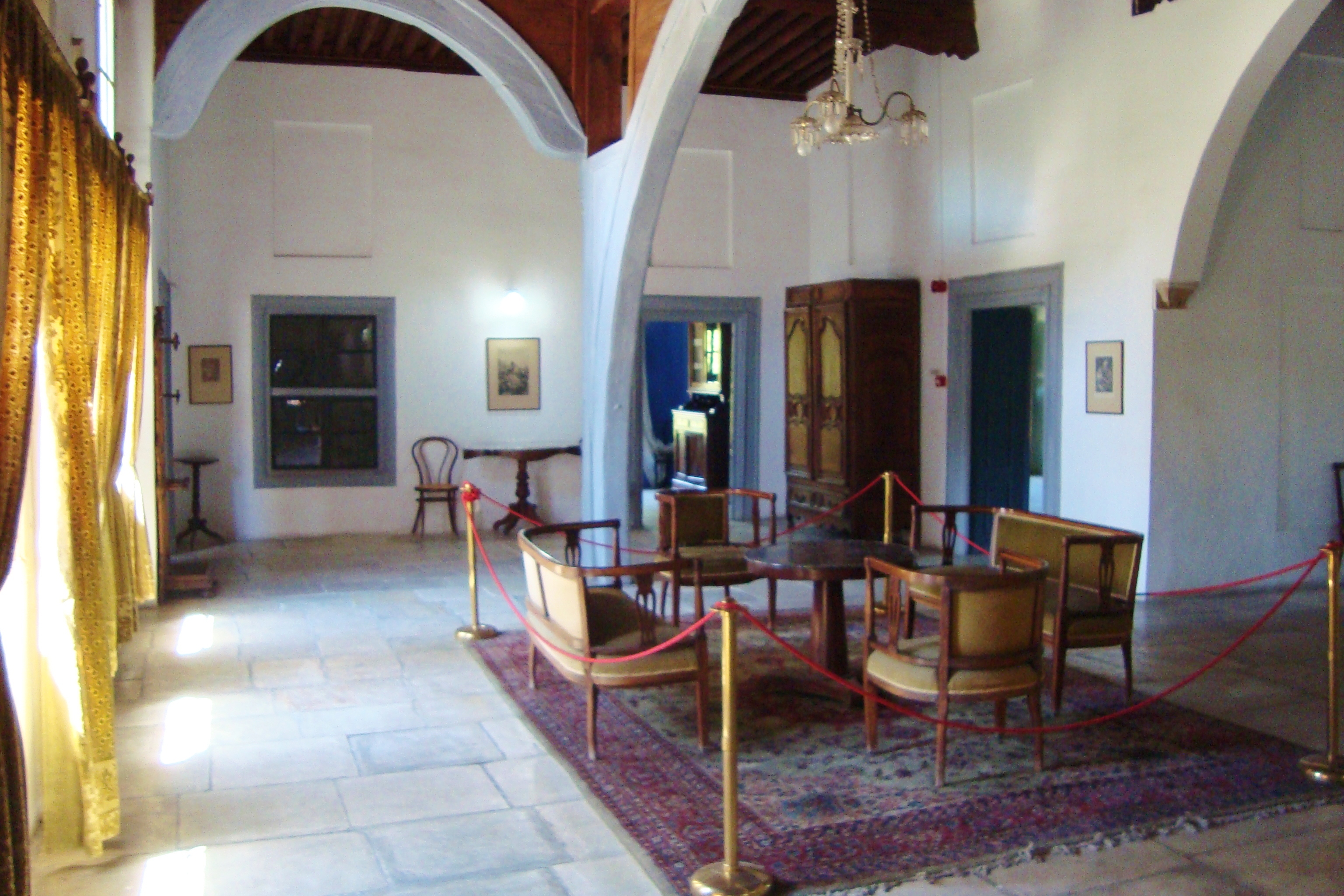Hadjigeorgakis Kornesios Mansion on:
[Wikipedia]
[Google]
[Amazon]
The Hadjigeorgakis Kornesios Mansion is situated near the Archbishopric, in the neighbourhood of Saint Antonios in Nicosia,
 The owner of the mansion, Hadjigeorgakis Kornesios, was a
The owner of the mansion, Hadjigeorgakis Kornesios, was a
File:Hadjigeorgakis Kornesios Mansion gardens in Nicosia Republic of Cyprus .jpg, Gardens of the mansion
File:Hamam Steam bath in Hadjigeorgakis Kornesios Mansion Nicosia Republic of Cyprus.jpg, Old Hamam of the mansion
File:Hadjigeorgakis Kornesios Cypriot Mansion living room in Nicosia Republic of Cyprus.jpg, Sitting room of the Dragoman
Museum website
Houses completed in 1793 Museums established in 1960 Houses in Cyprus Buildings and structures in Nicosia Museums in Nicosia History of Nicosia
Cyprus
Cyprus ; tr, Kıbrıs (), officially the Republic of Cyprus,, , lit: Republic of Cyprus is an island country located south of the Anatolian Peninsula in the eastern Mediterranean Sea. Its continental position is disputed; while it is ge ...
, where the wealthy notables of the Greek
Greek may refer to:
Greece
Anything of, from, or related to Greece, a country in Southern Europe:
*Greeks, an ethnic group.
*Greek language, a branch of the Indo-European language family.
**Proto-Greek language, the assumed last common ancestor ...
community traditionally used to live.
Overview
The mansion is the most important example of urban architecture of the last century of Ottoman rule that survives in old Nicosia. It opened on 3 May 1960 with the aid of public subscription, three years after a foundation was established to protect the property from developers who wanted to demolish the block.History of the house
 The owner of the mansion, Hadjigeorgakis Kornesios, was a
The owner of the mansion, Hadjigeorgakis Kornesios, was a dragoman
A dragoman or Interpretation was an interpreter, translator, and official guide between Turkish-, Arabic-, and Persian-speaking countries and polities of the Middle East and European embassies, consulates, vice-consulates and trading posts. A ...
, the official interpreter for the Divan (Council) of the Sultan for thirty years from 1779. This title, which was one of the most prestigious titles given to the local Christians
Christians () are people who follow or adhere to Christianity, a monotheistic Abrahamic religion based on the life and teachings of Jesus Christ. The words '' Christ'' and ''Christian'' derive from the Koine Greek title ''Christós'' (Χρ ...
by the Ottoman authorities, gave the opportunity to Kornesios to accumulate huge wealth and power. His power brought jealousy to his enemies, who cunningly managed to have him beheaded on 31 March 1809 in Constantinople
la, Constantinopolis ota, قسطنطينيه
, alternate_name = Byzantion (earlier Greek name), Nova Roma ("New Rome"), Miklagard/Miklagarth (Old Norse), Tsargrad ( Slavic), Qustantiniya ( Arabic), Basileuousa ("Queen of Cities"), Megalopolis ( ...
(modern day Istanbul
)
, postal_code_type = Postal code
, postal_code = 34000 to 34990
, area_code = +90 212 (European side) +90 216 (Asian side)
, registration_plate = 34
, blank_name_sec2 = GeoTLD
, blank_i ...
).
The house was built in 1793 with local bloc-cut sandstone
Sandstone is a clastic sedimentary rock composed mainly of sand-sized (0.0625 to 2 mm) silicate grains. Sandstones comprise about 20–25% of all sedimentary rocks.
Most sandstone is composed of quartz or feldspar (both silicates ...
and is a two-storey building. The monogram of the owner and the date of its erection can be seen on a marble tablet inside the entrance. The architectural plan of the building in the form of a Greek
Greek may refer to:
Greece
Anything of, from, or related to Greece, a country in Southern Europe:
*Greeks, an ethnic group.
*Greek language, a branch of the Indo-European language family.
**Proto-Greek language, the assumed last common ancestor ...
"Π" surrounds a central garden with a fountain and a private bathhouse (Hammam
A hammam ( ar, حمّام, translit=ḥammām, tr, hamam) or Turkish bath is a type of steam bath or a place of public bathing associated with the Islamic world. It is a prominent feature in the Islamic culture, culture of the Muslim world and ...
) which has three rooms. On the ground floor the servants’ quarters and the kitchen were situated. Roofed wooden stairs with a stone base lead to the entrance hall on the first floor from the courtyard. The official reception room and the living areas communicated with this reception hall. The official reception room (the onda), at the end of the east wing, differs from the other rooms with its exceptional carved wooden, gilded and painted decoration, which liken it to other official reception rooms in many mansions of the Ottoman Empire
The Ottoman Empire, * ; is an archaic version. The definite article forms and were synonymous * and el, Оθωμανική Αυτοκρατορία, Othōmanikē Avtokratoria, label=none * info page on book at Martin Luther University) ...
.
Today
Today the mansion, which was awarded theEuropa Nostra
Europa Nostra (Italian for "Our Europe") is a pan-European Federation for Cultural Heritage, representing citizens' organisations that work on safeguarding Europe's cultural and natural heritage. It is the voice of this movement to relevant inte ...
prize for its exemplary renovation work, functions as the Ethnological Museum, Lefkosia (The House of Hadjigeorgakis Kornesios). The address is: 20 Patriarchou Grigoriou St, Nicosia. The entrance fees is €2.50.
Gallery
See also
* Dervish Pasha Mansion *Tourism in Cyprus
Tourism in Cyprus occupies a dominant position in the country's economy, and has significantly impacted its culture and multicultural development throughout the years. In 2006, the tourism industry made up 10.7% of the country's GDP and the t ...
*History of Cyprus
Human habitation of Cyprus dates back to the Paleolithic era. Cyprus's geographic position has caused Cyprus to be influenced by differing Eastern Mediterranean civilisations over the millennia.
Periods of Cyprus's history from 1050 BC have ...
References
{{reflistExternal links
Museum website
Houses completed in 1793 Museums established in 1960 Houses in Cyprus Buildings and structures in Nicosia Museums in Nicosia History of Nicosia